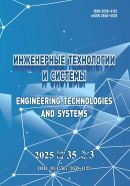UDK 629.3.01:004.94
DOI: 10.15507/2658-4123.030.202003.464-479
E-Tricycle Vehicle Design Based on Parametric CAD/CAE Models
Mikhail V. Chugunov
Head of Chair of Design and Technology Informatics of Ruzaevka Institute of Mechanical Engineering, National Research Mordovia State University (68 Bolshevistskaya St., Saransk 430005, Russia), Ph.D. (Engineering), Associate Professor, Researcher ID: H-7452-2018, ORCID: https://orcid.org/0000-0001-5318-5684, This email address is being protected from spambots. You need JavaScript enabled to view it.
Irina N. Polunina
Associate Professor of Chair of Design and Technology Informatics of Ruzaevka Institute of Mechanical Engineering, National Research Mordovia State University (68 Bolshevistskaya St., Saransk 430005, Russia), Ph.D. (Pedagogy), Researcher ID: H-7473-2018, ORCID: https://orcid.org/0000-0002-1093-8401, This email address is being protected from spambots. You need JavaScript enabled to view it.
Anton M. Pjanzin
Student of Ruzaevka Institute of Mechanical Engineering, National Research Mordovia State University (68 Bolshevistskaya St., Saransk 430005, Russia), This email address is being protected from spambots. You need JavaScript enabled to view it.
Introduction. National Technology Initiatives (STI), designed to develop and implement High-Tech tools into engineering practice and based on the Industry 4.0 concept, require appropriate technical solutions for all phases of the product lifecycle from design to disposal. Implementation of the concept involves the formation of technological groups and markets in different directions in particular one of the emerging markets of STI is Auto.Net. At the same time, the product design stage is basic and should be implemented in a form ensuring the entire life cycle of the product on the principles of this concept.
Materials and Methods.The article presents the methodology and results of designing an electric vehicle-tricycle in the integrated CAD/CAE systems. The design process is the development of digital parametric models of different types and levels on a top-down and bottom-up basis. The parametric properties of models provide the ability to develop design solutions efficiently, including design, analysis and optimization. The design solutions are developed in the CAD/CAE/CAM/PDM/PLM SolidWorks (Motion, Simulation) software.
Results. The results of the study are rational design paths for the structures of the class under consideration in the SolidWorks software, as well as design solution of the electric tricycle-vehicle in the form of a system of integrated parametric models, including 3D models of parts and assemblies, models of solid-state mechanics, finite-element models for solving problems of mechanics of the deformed solid body in the form of linear and non-linear statics, linear dynamics, parametric optimization. Videos of the results are provided for illustrative purposes.
Discussion and Conclusion. In the research, the design trajectory of the electric vehicletricycle based on correct formulation for the design problems and providing the rational choice of means, tools, and technologies from basic SolidWorks functionality is presented. The trajectory provides both an efficient solution to design problems and an assessment of the adequacy of the results obtained. In terms of the possible perspective of this work, it is necessary to specify the solution of optimization tasks according to various criteria of project efficiency and the development of an integrated (cyber-physical) model of electric vehicle-tricycle, which meets the requirements of digital twins. At the same time, bidirectional associative links between virtual and physical components of the integrated model will solve a number of additional problems: control of the accuracy of digital models, giving the digital model synergistic properties, planning of the trajectory and unmanned control on the principles of IoT (Internet of Things).
Keywords: electric vehicle, CAD, CAE, dynamics and strength, vehicle modeling, FEM, digital twin for car
For citation: Chugunov M.V., Polunina I.N., Pjanzin A.M. E-Tricycle Vehicle Design Based on Parametric CAD/CAE Models. Inzhenerernyye tekhnologii i sistemy = Engineering Technologies and Systems. 2020; 30(3):464-479. DOI: https://doi.org/10.15507/2658-4123.030.202003.464-479
Contribution of the authors: M. V. Chugunov – research methodology development and model building for electric vehicles; I. N. Polunina – development of research methodology and model building for electric vehicles, numerical analysis; A. M. Pjanzin – numerical analysis.
All authors have read and approved the final manuscript.
Received 07.03.2020; revised 20.05.2020; published online 30.09.2020
REFERENCES
1. Borovkov A.I., Rozhdestvenskiy O.I., Ryabov Yu.A., et al. National Technology Initiative Center for Advanced Manufacturing Technologies of Peter the Great St. Petersburg Polytechnic University. Innovatsii = Innovations. 2019; (11):73-88. Available at: https://maginnov.ru/ru/zhurnal/arhiv/2019/innovacii-n11-2019/centr-kompetencij-nacionalnoj-tehnologicheskoj-iniciativy-novye-proizvodstvennye-tehnologii-sankt-peterburgskogo-politehnicheskogo-universiteta-petra-velikogo (accessed 07.08.2020). (In Russ.)
2. Leventsov V.A., Radaev A.E., Nikolaevskiy N.N. The Aspects of the “Industry 4.0” Concept within Production Process Design. Nauchno-tekhnicheskie vedomosti SPbGPU. Ekonomicheskie nauki = St. Petersburg State Polytechnical University Journal. Economics. 2017; 10(1):19-31. Available at: https://institutiones.com/industry/2981-aspekty-koncepcii-industriya-4-0.html (accessed 07.08.2020). (In Russ.)
3. Agarwal D., Robinson T.T., Armstrong C.G. A CAD Based Framework for Optimizing Performance While Ensuring Assembly Fit. In: ICSEE 2018, IMIOT 2018. Communications in Computer and Information Science. Singapore: Springer; 2018. 923:73-83. Available at: https://link.springer.com/chapter/10.1007%2F978-981-13-2396-6_7 (accessed 07.08.2020). (In Eng.)
4. Jung M., Cho H., Roh T., et al. Integrated Framework for Vehicle Interior Design Using Digital Human Model. Journal of Computer Science and Technology. 2009; 24:1149-1161. (In Eng.) DOI: https://doi.org/10.1007/S11390-009-9287-3
5. Boikov V.G., Gaganov I.V., Fayzullin F.R. Modeling the Motion of a Mechanical System Consisting of Deformable Elastic Bodies, by Integrating Two Packages: EULER and FIDESYS. Chebyshevskiy sbornik = Chebyshevskii Sbornik. 2017; 18(3):131-153. Available at: https://www.chebsbornik.ru/jour/article/view/352/317 (accessed 07.08.2020). (In Russ.)
6. Gorelov V.A., Komissarov A.I., Kositsyn B.B. Passenger Car Motion Modeling in a Multibody Dynamics Simulation Software. Zhurnal avtomobilnykh inzhenerov = Automotive Engineers’ Journal. 2016; (1):18-23. Available at: http://www.aae-press.ru/f/96/18.pdf (accessed 07.08.2020). (In Russ.)
7. Savkin A.N., Gorobtsov A.S., Andronik A.V., et al. Operating Load Analysis of Heavy Duty Truck Frame. Izvestiya Volgogradskogo gosudarstvennogo tekhnicheskogo universiteta. Seriya: nazemnye transportnye sistemy = Volgograd State Technical University News. Series: Ground Transport Systems. 2015; 11(5):25-29. Available at: http://www.vstu.ru/files/vstu_periodical/4793/upload/no_5165_-_2015.pdf (accessed 07.08.2020). (In Russ.)
8. Kravets A., Shcherbakov M., Kultsova M., et al. Simulation and Visualization Software for Vehicle Dynamics Analysis Using Multibody System Approach. In: Creativity in Intelligent Technologies and Data Science. Communications in Computer and Information Science. Cham: Springer; 2015. 535:378-390. Available at: https://link.springer.com/chapter/10.1007%2F978-3-319-23766-4_30 (accessed 07.08.2020). (In Russ.)
9. Hasagasioglu S., Kilicaslan K., Atabay O., et al. Vehicle Dynamics Analysis of a Heavy-Duty Commercial Vehicle by Using Multibody Simulation Methods. The International Journal of Advanced Manufacturing Technology. 2012; 60:825-839. (In Eng.) DOI: https://doi.org/10.1007/s00170-011-3588-8
10. Burcham M.N., Escobar R., Yenusah C.O., et al. Characterization and Failure Analysis of an Automotive Ball Joint. Journal of Failure Analysis and Prevention. 2017; 17:262-274. (In Eng.) DOI: https://doi.org/10.1007/s11668-017-0240-4
11. Ambrosio J., Verissimo P. Improved Bushing Models for General Multibody Systems and Vehicle Dynamics. Multibody System Dynamics. 2009; 22:341-365. (In Eng.) DOI: https://doi.org/10.1007/s11044-009-9161-7
12. Vesali F., Rezvani M.A., Kashfi M. Dynamics of Universal Joints, Its Failures and Some Propositions for Practically Improving Its Performance and Life Expectancy. Journal of Mechanical Science and Technology. 2012; 26(8):2439-2449. (In Eng.) DOI: https://doi.org/10.1007/s12206-012-0622-1
13. Barton D.C., Fieldhouse J.D. Suspension Systems and Components. In: Automotive Chassis Engineering. Cham: Springer; 2018. Pp. 111-124. (In Eng.) DOI: https://doi.org/10.1007/978-3-319-72437-9_3
14. Borisenko V., Kiselev A., Leoro L., et al. K&C Suspension Parameters Stability by Production Tolerances. E3S Web of Conferences. 2019; 140. 6 p. (In Eng.) DOI https://doi.org/10.1051/e3sconf/201914007007
15. Jinturkar A., Channa R., Mistry R., et al. Weight Reduction of FSAE Vehicle Using TRIZ Principle. In: ICoRD 2017: Research into Design for Communities, Vol. 1. Singapore: Springer; 2017. Pp. 861-870. Available at: https://link.springer.com/chapter/10.1007%2F978-981-10-3518-0_74 (accessed 07.08.2020). (In Eng.)
16. Chugunov M.V., Kechemaykin V.N., Panin M.V., et al. Static Strength and Stiffness Analysis for Bearing Structure Elements of Electro Car BravoEgo. Naukovedenie = Sociology of Science. 2016; 8(3). 22 p. Available at: http://naukovedenie.ru/PDF/134TVN316.pdf (accessed 07.08.2020). (In Russ.)
17. Daberkow A., Kreuzer E. An Integrated Approach for Computer Aided Design in Multibody System Dynamics. Engineering with Computers. 1999; 15:155-170. (In Eng.) DOI: https://doi.org/10.1007/s003660050011
18. Bradley J., Tansley G.D., Dominy J. A Modelling Strategy for Vehicle Dynamics Using Pro/ ENGINEER. Sports Engineering. 2009; 11:119-129. (In Eng.) DOI: https://doi.org/10.1007/s12283-009-0017-4
19. Alekseev S., Tarasov A., Borovkov A., et al. NVH Analysis of Offroad Vehicle Frame. Evaluation of Mutual Influence of Body-Frame System Components. Materials Physics and Mechanics. 2017; 34(1):70-75. (In Eng.)

This work is licensed under a Creative Commons Attribution 4.0 License.

















